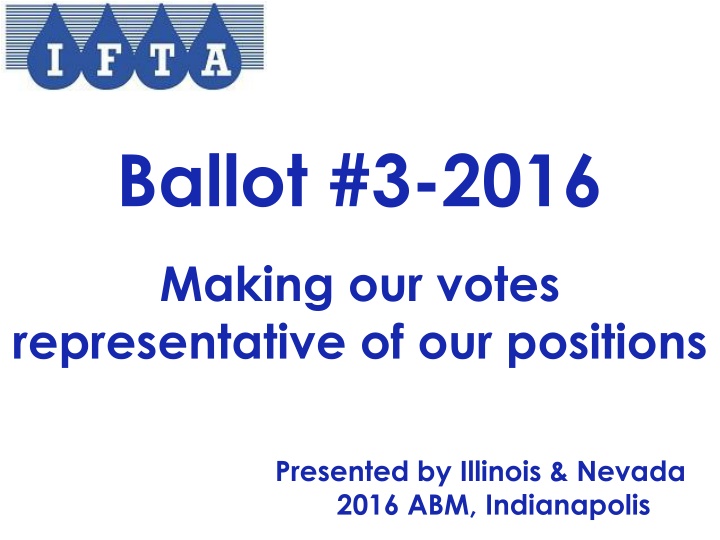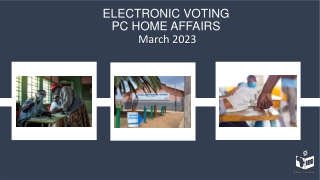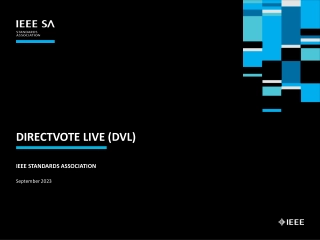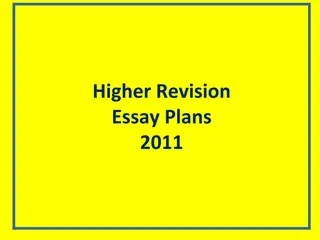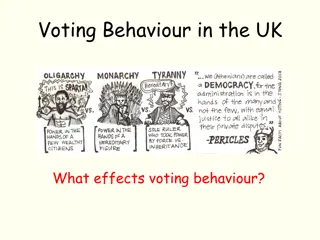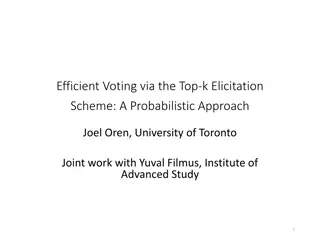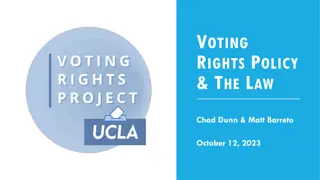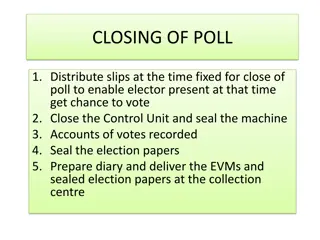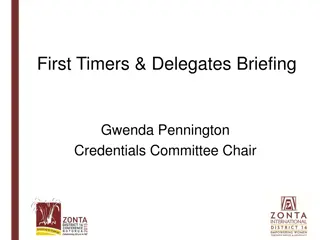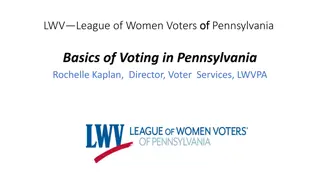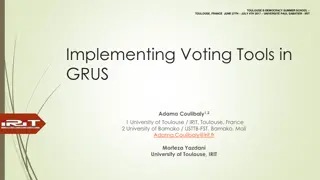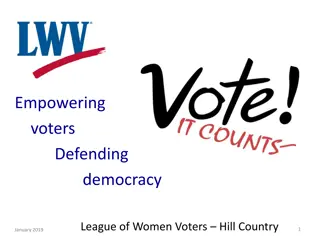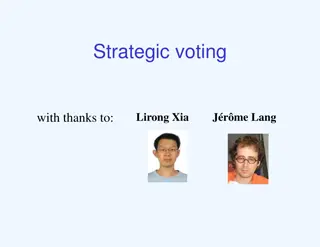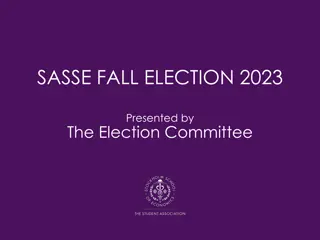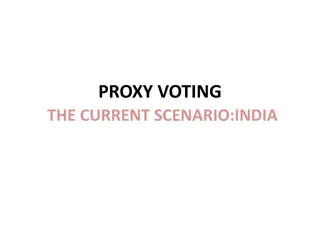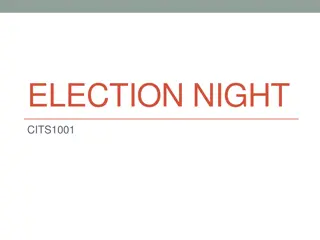Making Votes Truly Representative: Ensuring Fair Voting Practices
Enhance voting integrity by accurately reflecting eligible jurisdictions' positions. Address issues of non-voters' influence on outcomes, misrepresentation of abstentions, and inaccuracies in voter tallies.
Download Presentation

Please find below an Image/Link to download the presentation.
The content on the website is provided AS IS for your information and personal use only. It may not be sold, licensed, or shared on other websites without obtaining consent from the author.If you encounter any issues during the download, it is possible that the publisher has removed the file from their server.
You are allowed to download the files provided on this website for personal or commercial use, subject to the condition that they are used lawfully. All files are the property of their respective owners.
The content on the website is provided AS IS for your information and personal use only. It may not be sold, licensed, or shared on other websites without obtaining consent from the author.
E N D
Presentation Transcript
Ballot #3-2016 Ballot #3-2016 Making our votes representative of our positions Presented by Illinois & Nevada 2016 ABM, Indianapolis
Intent: To ensure a vote s final outcome is representative of the eligible jurisdictions voting position as truly intended.
How do we do this? 1. By ensuring the denominator on which the final vote is tallied represents only on those eligible jurisdictions that have cast a vote. 2. By ensuring a position of Abstain is just that: a recognized position that is neither a vote of Yes or No .
What Is Happening in IFTAs Voting Process Today? Non-voters (i.e. those not physically casting a vote) are counted as a NO vote.
But What is Really Happening: Jurisdictions are being assigned a vote of NO whether that is their true intention or not. Non-voters are included in the denominator of 58. Non-voters influence the outcome of the vote.
What Else Is Happening in IFTAs Voting Process Today? Abstentions are allowed.
But What is Really Happening: Jurisdictions abstaining are being assigned a vote of NO : clearly not their intention. Those abstaining (Non-voters) are included in the denominator of 58. Non-voters influence the outcome of the vote.
Is There More Happening in IFTAs Voting Process Today? Every vote taken is tallied on the constant denominator of 58 member jurisdictions.
But What is Really Happening: Jurisdictions that have lost their voting privileges are being counted in the mix of 58 with a NO vote being assigned to them. Jurisdictions without having a Commissioner identified are being counted in the mix of 58 with a vote of NO being assigned to them. Jurisdictions absent from the ABM without a voting delegate named are being counted in the mix of 58 with a vote of NO being assigned to them.
Clarifications requested during the 1st Comment Period Quorum language Abstentions Defining the base (denominator) on which to tally the vote
Clarification: Quorum or Minimum Required ASSC: Require a quorum present in order to vote: 30 23 affirmative votes needed to pass OK: Require a minimum of votes cast (floor): 40 30 affirmative votes needed to pass CT: A Super Majority must cast a vote: 44 33 affirmative votes needed to pass
BUT Having these requirements is just like today Identifying a specific minimum requirement of votes that must be cast, non-voters still influence the outcome of the vote.
Example: A Super-Majority of 44 votes cast are needed in order for the vote to be official. Scenario: A total of 43 votes are cast. All 43 votes are cast in the affirmative: 100% of the total votes cast are in favor of this ballot. None of the 15 remaining jurisdictions are in favor of the ballot. Outcome: The 15 remaining jurisdictions realize that if only one NO vote is cast, a super-majority is then met and the ballot will pass 43-1. However, if the 15 remaining jurisdictions do not cast a vote at all, the vote does not become official because a super-majority of 44 votes was not met: the ballot fails. Non-voters influenced this vote.
Clarification: Abstentions Just as today, you still have the right to Abstain from voting, but this ballot proposes: you will no longer be assigned a vote of NO as is the case today, and you will be recognized as formally abstaining from voting, but; you will not be counted in the tally of the vote since you did not cast a vote.
Clarification: The Denominator - The base on which to tally the vote The denominator will be based only on: 1. Jurisdictions that are eligible to vote. 2. Jurisdictions that physically cast a vote.
Clarification: The Denominator - The base on which to tally the vote What are eligible jurisdictions: 1. Jurisdictions that have maintained their voting privileges. 2. Jurisdictions that have a Commissioner named at the time of the vote. 3. Jurisdictions that have named a voting delegate (proxy) in their absence.
Complicated? Not really: Total Membership Minus sanctioned jurisdictions Minus unidentified Commissioners Minus unidentified delegates Minus non-voters Denominator Example: 58 2 2 2 4 48 x 75% = 36 36 affirmative votes needed to pass in this example
-Or- Simply: 75% of the votes cast sanctioned jurisdictions unidentified Commissioners unidentified delegates non-voters
If you are still concerned about the Votes cast language We already have it. *R1555 COMPLIANCE MATTERS .300 Initiation of a Dispute Based on a Final Determination Finding of Non-Compliance .020 An affirmative vote in writing of at least two-thirds of the total written votes cast is required to initiate a dispute based on a Final Determination Finding of Non-Compliance.
Additional Comments Received Changing the language to votes cast means the Agreement can be amended by only a few jurisdictions. There s no indication the current voting system is broken.
IFTAs Voting History Indicates Just the Opposite Since 2008: Final Vote participation is 92.39% (92% = 54 votes cast) 20 jurisdictions physically cast a vote 100% of the time 24 jurisdictions physically cast a vote 90% of the time 7 jurisdictions voted between 80-90% of the time 7 jurisdictions voted less than 80% of the time The lowest participating jurisdiction: 53% (excludes New Jersey) The lowest voting participation on a single ballot: 71% (41)
IFTAs Voting History Indicates The System Is Broken Ballot #1-2012: 1st Comment Period: Support: 34 Oppose: 3 Undecided: 4 No Comments: 17 2nd Comment Period: Support: 17 Oppose: 0 Undecided: 1 No Comments: 40 Final Vote: Support: 43 Oppose: 9 Non-voters: 6
Ballot #1-2012 Proves The System Is Broken Ballot #1-2012: Final Vote: Support: 43 Oppose: 9 Non-voters: 6 Of those 6 Non-voter jurisdictions, 4 jurisdictions supported this ballot through two Comment Periods. Had only one of those supporting non- voter jurisdictions actually cast a Final Vote, this ballot would have passed.
New Jersey Proves The System Is Broken New Jersey commented support to the following ballots: 2012 - #1, #3, #4, #5 2013 - #1, #2, #3 2014 - #3 This acknowledges New Jersey s position is being misrepresented by today s voting process. James Walker, NJ 08/01/2016
In Closing, Hundreds of hours can be expended upon a single ballot: Time invested by the ballot sponsors Time invested by IFTA, Inc. Time invested by various committees Time invested by your Commissioner and by your department s staff Time invested by the trucking industry
In Closing, Hundreds of hours can be expended upon a single ballot: Time invested by the ballot sponsors Time invested by IFTA, Inc. Time invested by various committees Time invested by your department s staff Time invested by the trucking industry $ $ $ $ $ Please consider supporting this ballot to reflect a true voting outcome that is representative of the eligible member jurisdictions.
Questions? Thank You! Cindy & Trent
